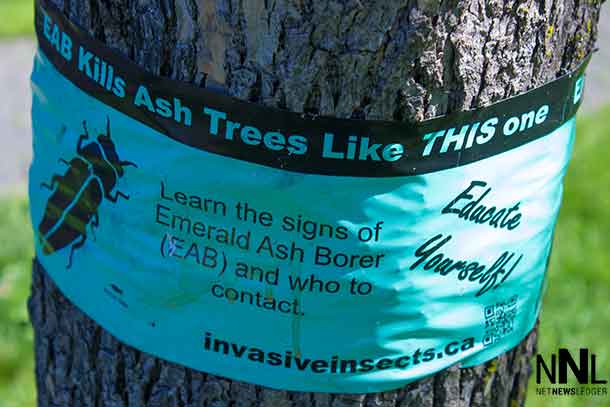
THUNDER BAY – Since the Emerald Ash Borer (EAB) was detected in Thunder Bay in late June, the City and partner organizations have taken additional steps to increase awareness of the insect’s arrival and how to slow its spread in the community.
The first of two public information sessions was hosted yesterday in partnership with the Invasive Species Centre and the Ontario Invasive Plant Council. Through a formal presentation, informative resources, and interactive examples, attendees learned about EAB identification, ash identification, signs and symptoms of infested trees, restrictions and regulations, and tree treatment options.
“Presented to Council on July 18, our EAB recommended response plan supports ongoing education to let residents know how they can contribute to EAB monitoring and management efforts,” said Shelley Vescio, City Forester and Chair of the Northwestern Ontario EAB Task Force. “As the City explores management options for municipally-owned trees, residents are encouraged to consult the resources we have to offer on how to look for EAB and treatment options for ash trees on private property.”
In addition, the City and its partners are working diligently to determine whether trees in other areas are affected. Among the many ongoing detection efforts, the Ministry of Natural Resources and Forestry continues to sample ash trees using a proven early-detection branch-sampling technique. Additional visual detection surveys in the ash-dense regions to the north and south of the area in which EAB was initially discovered are also being conducted with trained volunteers from partner organizations.
“Over the past two days, survey crews examined ash trees on city-owned property for signs of EAB, reported trees suspected of possible infestation, and collected samples such as bark and larvae for proper identification,” said Taylor Wright, Project Coordinator with the Invasive Species Centre. “This work, coupled with more than 120 green prism detection traps in City ash trees, is critical in determining the extent of the infestation.”
Residents and visitors can also play a role in preventing the spread of EAB by not moving firewood. The Canadian Food Inspection Agency will determine a quarantine zone later this year, which will prohibit the movement of any wood from the City and therefore it should be burnt or used on site.
Residents can learn more about EAB and its presence in the City at a second public information session from 4-6 pm today at the Oliver Road Community Centre. For more information, visit www.thunderbay.ca/eab
